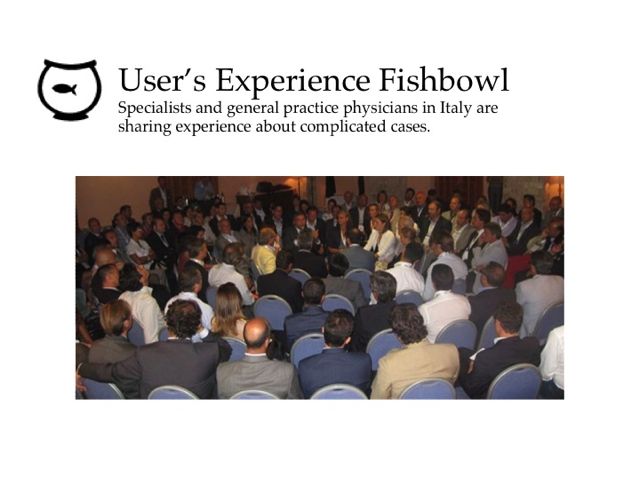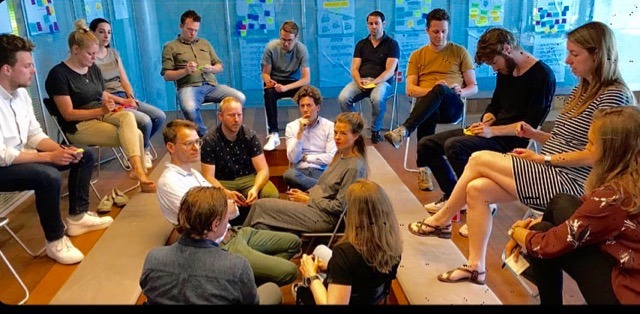![]() User Experience Fishbowl
User Experience Fishbowl
Share Know-How Gained from Experience with a Larger Community (35-70 min.)
What is made possible? A subset of people with direct field experience can quickly foster understanding, spark creativity, and facilitate adoption of new practices among members of a larger community. Fishbowl sessions have a small inside circle of people surrounded by a larger outside circle of participants. The inside group is formed with people who made concrete progress on a challenge of interest to those in the outside circle. The fishbowl design makes it easy for people in the inside circle to illuminate what they have done by sharing experiences while in conversation with each other. The informality breaks down the barriers with direct communication between the two groups of people and facilitates questions and answers flowing back and forth. This creates the best conditions for people to learn from each other by discovering answers to their concerns themselves within the context of their working groups. You can stop imposing someone else’s practices!
Five Structural Elements – Min Specs
1. Structuring Invitation
- Ask those in the fishbowl to describe their experience—the good, the bad, and the ugly—informally, concretely, and openly. Invite them to do it in conversation with each other as if the audience wasn’t there and they were sharing stories around a watering hole or stuck in a van on the way to the airport. Firmly, ask them to avoid presenting to the audience.
- Invite the people outside the fishbowl to listen, observe nonverbal exchanges, and formulate questions within their small groups.
2. How Space Is Arranged and Materials Needed
- Three to 7 chairs in a circle in the middle of a room
- Microphones for inner circle if whole group is larger than 30 to 40
- If possible, a low stage or bar stools make it possible for people in the outer circle to better see the interactions
- As many chairs as needed in an outer circle around the inner circle, in clumps of 3 to 4 chairs
- In large groups, have additional microphones ready for outside circle questions
3. How Participation Is Distributed
- Everyone in the inner circle has an equal opportunity to contribute
- Everyone in the outer circle has an equal opportunity to ask questions
4. How Groups Are Configured
- One inner circle group of 3–7 people
- One outer circle in multiple small satellite groups of 3–4 people
- 1-2-4-All configuration for the debrief
5. Sequence of Steps and Time Allocation
- Explain the fishbowl configuration and steps. 2 min.
- Inner circle conversation goes on until it ends on its own. 10 to 25 min.
- Satellite groups in outer circle formulate observations and questions. 4 min.
- Questions submitted to the inner circle are answered, and back-and-forth interaction between inner and outer circles goes on as needed until all the questions are answered. 10 to 25 min.
- Debrief using W³ (What? So What? Now What?) and ask, “What seems possible now?” 10 to 15 min.
WHY? Purposes
- Get down-to-earth field experience and all the questions and answers about new endeavors out on the table for everyone to understand at the same time
- Create conditions for new ideas to emerge
- Make space for every participant’s imagination and experience to show up
- Build skills in listening, storytelling, pattern-finding, questioning, and observing
- Celebrate early adopters and innovators who have gained field experience (often failing forward and vetting the prototype)
Tips and Traps
- For inner circle, pick only people with direct personal experience (without regard to rank)
- Pick people for the fishbowl (inner circle) who are representative of the distinct roles and functions that require coordination for success
- Encourage inner-circle people to share concrete, very descriptive examples rather than opinions
- Advise inner-circle people to imagine being in a car or a bar sharing stories and having a conversation
- Encourage everyone to share both successes and failures, “the good, the bad, the ugly”
- Enforce the “no speeches” and “talk to each other, not to the outer circle” rules!
- Collect ALL the questions from the outside circle before the "fish" restart their conversation
- Based on the overall pattern of questions, give the "fish" a choice of which questions to address
- Have fun and encourage animated storytelling
Riffs and Variations
- Leave an open chair in the inner circle for someone with experience to unexpectedly jump in
- With virtual groups, people in the outside circle use the chat function to share questions “to all” or in “pairs” as the conversation unfolds among “the fishes of the inner circle.”
- Mash-up or string together User Experience Fishbowl with Improv Prototyping, 25/10 Crowd Sourcing, Ecocycle Planning, Simple Ethnography, Shift & Share
 Inner and outer circles in full swing. In small groups, the outer circle generates BIG questions to dig deeper into the challenge. “What questions, if answered or addressed, would help up move forward?".
Inner and outer circles in full swing. In small groups, the outer circle generates BIG questions to dig deeper into the challenge. “What questions, if answered or addressed, would help up move forward?".
Examples
- For transferring on-the-ground knowledge from officers returning from Afghanistan to those replacing them (see “Transforming After-Action Reviews in the Army” in Part Three: Stories from the Field).
- During a Liberating Structures workshop, a few experienced practitioners share stories to deepen the understanding of new users about how to get started and how to get practical results
- During a doctors’ meeting, an inner circle of specialists discussed a challenging case in the middle of a group of primary-care physicians, sparking a discussion of the case from specialist and primary-care perspectives
- A pilot group of salespeople shared with the rest of the sales force their experience with a new handheld reporting device. The User Experience Fishbowl helped everybody become comfortable that they knew all they needed to know to adopt the innovation.
- For a public-sector organization trying to expand beyond “hidden” pockets of uplifting service
- Members of an executive management team conducted their meeting in a fishbowl surrounded by all their managers.
Attribution: Liberating Structure developed by Henri Lipmanowicz and Keith McCandless and inspired by immersing ourselves in many different kinds of fishbowls over the years.
Collateral Material
Below: Presentation materials we use to introduce Users Experience Fishbowl

 Great setting for a UX Fishbowl in Amsterdam
Great setting for a UX Fishbowl in Amsterdam
